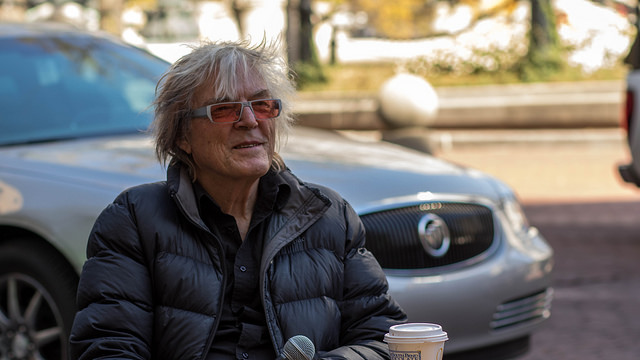by Chris Shumerth
David Engwicht was the son of a traveling preacher. As such, he felt like an outsider in schools, churches, and even in the places his family stayed. What that “vagabond” lifestyle did, according to Engwicht, was “to create in him an inner ache for home.”
Perhaps it was inevitable then, that the Australian became a professional placemaker (and founder of Creative Communities International), but it took a major turn to get there. “I was a high school dropout who was washing windows for a living,” Engwicht explained at a brown bag lunch at Spark Monument Circle last month during his week-long stay in Indianapolis at the invitation of Big Car.
As a window-washer, Engwicht got involved in a fight in his town over a road-widening initiative. “Traffic is us in our cars,” Engwicht said. “We can’t ask for this road not to be widened unless we’re willing to use our cars less.” He went on to say that “Traffic is a social problem, not a design problem.”
Engwicht was well on his way to inventing the “walking school bus” and writing the 1999 book, Street Reclaiming: Creating Livable Streets and Vibrant Communities, among other works.
“Placemaking is like homemaking,” Engwicht said at his talk at TEDxIndianapolis at the University of Indianapolis. In placemaking, he said, we try to take a public space and turn it into a place. The two things aren’t the same, and the goal is the feeling of home.
Placemaking, according to Engwicht, should do two things. It should create transformative experiences for people, and it should become the antidote to our addiction to movement.
When I talked to Engwicht after TEDxIndianapolis, he noted that the United States seems especially movement-oriented and that even Indianapolis’s bike lanes would benefit from a few more “linger nodes.”
Maybe Engwicht’s vocation doesn’t completely abandon his roots, because there seems to be something prophetic, if not downright spiritual, about Engwicht’s ideas.
He’s an advocate of what he calls “deep placemaking,” which seeks to address not just the surface-level dilemmas of towns and cities and traffic, but rather the stories behind the problems that come up.
According to Engwicht, deep placemaking has to address three main meta-narratives that are often ingrained in a community. The first story is one of identity, and limits: the “I am just…” story. Engwicht termed a second kind of story as the “we will fly when” story. The old kick-the-can-down-the-road story. And the third story that deep placemaking has to counter is the roadblock story, i.e. red tape, bureaucracy, retailers, and the like.
In order to fight one’s way around these roadblocks, Engwicht recommended taking action by calling an initiative “a trial.” During the trial, one ought to collect some data and write the necessary report with the hopes that the experiment becomes permanent. The key, you may notice, is that the action precedes the report, rather than the other way around.
But what about problems like repetitive vandalism or violence? What then?
According to Engwicht, the principles still apply. Traditional responses too often tend to “outsource civic responsibility.” Instead, Engwicht argued that, “the only way to solve (these kinds of problems) is to develop a civic relationship with the perpetrators.”
“It costs us to build trust,” he added.
In his consulting work, Engwicht likes to start by creating “red-tape-reduction groups” charged with seven-day makeovers.
What do we have? What am I willing to give? A resources bank is the starting point, according to Engwicht, and not so much elaborate wish lists that will probably never come to fruition. The idea is to create the kind of community people want from what they already have.
“Take your vision of the future, and live that way now,” Engwicht told me. “If your future isn’t committee meetings, then stop going.”
Engwicht said citizens often only know about twenty percent of what they want at the beginning of the process; that is to say they discover the eighty percent by going on “a voyage of discovery.”
“We built more community in two months of sitting on our lawn chairs eating dinner than in 20 years of bitching and moaning about city hall,” Engwicht said in his TEDxIndianapolis talk.
I was lucky enough to participate in an abbreviated version of Engwicht’s start-up process at a session sponsored by Reconnecting to our Waterways. In addition to Engwicht, the event featured by Anthony Garcia, a Miami tactical urbanist who also spoke at Indianapolis’s recent TEDx.
The placemaking workshop attracted a few dozen professionals from the city who were tasked with creating a resources bank for the various waterways in Indianapolis. I sat down at the Fall Creek table with Bonnie Mill and David Orr of The Sapphire Theatre Company, and Corrie Meyer, a landscape architect and urban planner.
Through the process of brainstorming, we discovered that the theatre company possesses several already-built, four-sided wooden platforms, which could be used to create linger nodes along the trail for graffiti projects, performance art, and/or yoga classes.
So if you’re an Indianapolis resident who frequents the Fall Creek area, keep your eyes out!

